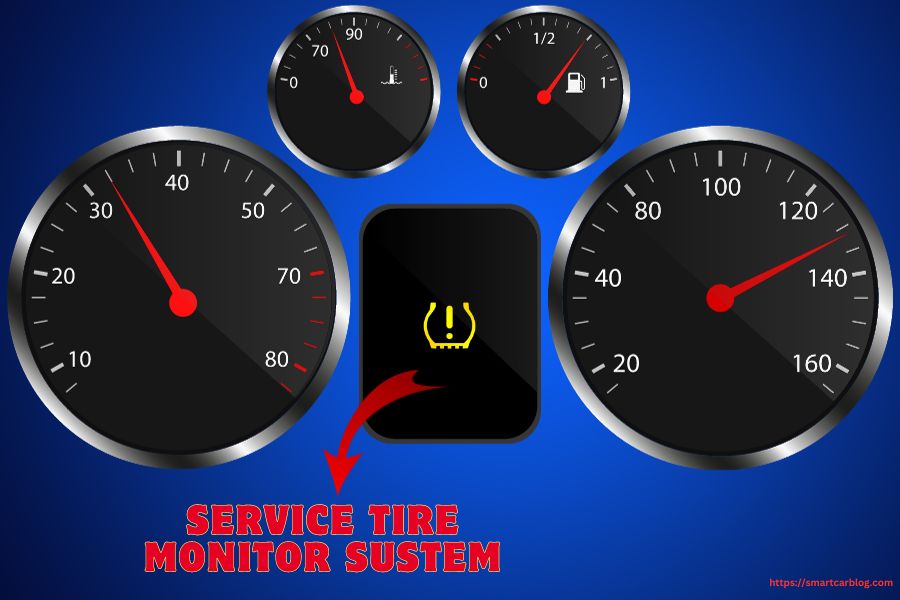Understanding the Service Tire Monitor System (STMS) is fundamental for every vehicle owner. In essence, STMS is a sophisticated technology integrated into modern vehicles to monitor tire pressure, ensuring optimal performance and safety on the road. This innovative system goes beyond the conventional tire pressure checks, providing real-time data and alerts about the condition of your tires. But what does this mean for you as a driver? How does it impact your driving experience and safety?
In this comprehensive guide, we will explain the depths of the Service Tire Monitor System, unraveling its significance, functionality, and the crucial role it plays in keeping you and your passengers safe during your journeys. Join us on this exploration to demystify the world of STMS and discover how it contributes to enhancing your driving experience.
Table of Contents
ToggleUnderstanding Vehicle Monitoring Systems
Vehicle monitoring systems are technological marvels designed to keep drivers informed about various aspects of their car’s health and performance. Think of them as the car’s way of communicating with you. From engine performance to fuel efficiency and now to tire health – these systems ensure that drivers are always in the loop about potential issues or areas of concern.
Now, amongst these, the STMS stands out. It’s specifically designed to monitor the pressure and overall health of the tires, alerting the driver when something is a miss. When you see an alert saying “Service Tire Monitor System,” it’s your vehicle’s way of telling you to pay attention to your tires, either due to a system malfunction or a genuine tire issue.
Importance of Tire Health in Vehicle Safety
Tire health is paramount when it comes to vehicle safety. Tires are the only part of the car in direct contact with the road, bearing the entire weight of the vehicle. Properly maintained tires can be the difference between a smooth, safe drive and a potential mishap. They ensure optimal grip, handling, and braking performance, especially in challenging driving conditions.
Neglecting tire health can lead to uneven tire wear, poor fuel efficiency, and even catastrophic tire failures. This is why monitoring systems like STMS are crucial. They serve as an early warning system, ensuring that any discrepancies in tire pressure or health are promptly addressed.
In essence, understanding “what does a service tire monitor system mean” can be a key step towards ensuring your safety on the road. By paying heed to these alerts and understanding the importance of tire health, drivers can ensure a safer and more efficient driving experience. It’s all about being proactive and informed, and the STMS is there to assist in that very mission.
Basics of Service Tire Monitor System
Understanding the Service Tire Monitor System (STMS) starts with grasping the fundamental elements of Tire Pressure Monitoring Systems (TPMS). TPMS is a vital technology integrated into modern vehicles, playing a crucial role in ensuring safety and optimal performance on the road.
What is a Tire Pressure Monitoring System (TPMS)?
A Tire Pressure Monitoring System, or TPMS, is an advanced automotive safety feature designed to monitor the tire air pressure in real-time. Its primary objective is to alert drivers when tire pressure falls below a certain threshold. By detecting under-inflated tires promptly, TPMS enhances vehicle safety, improves fuel efficiency, and prolongs tire life. TPMS has become a standard in many vehicles driven by its ability to prevent accidents and enhance the overall driving experience.
History and Development of TPMS
The evolution of TPMS dates back to the late 1980s when automotive engineers recognized the need to address the dangers of under-inflated tires. As technology advanced, TPMS systems became more sophisticated, integrating various sensor technologies and communication protocols. In the early 2000s, regulations were implemented mandating the inclusion of TPMS in new vehicles, marking a significant milestone in automotive safety standards. The continuous development of TPMS reflects the industry’s commitment to improving road safety and reducing accidents caused by tire-related issues.
How TPMS Sensors Work
TPMS sensors are the core components of the system, usually located inside each tire. These sensors utilize different methods, such as direct pressure monitoring or indirect monitoring through wheel speed sensors, to measure tire pressure. When a tire’s pressure deviates from the recommended level, the sensors send data to the vehicle’s onboard computer. If the pressure falls below the safe threshold, TPMS alerts the driver through a warning light on the dashboard, indicating the specific tire requiring attention. Understanding the intricacies of TPMS sensor functionality is key to appreciating how this technology ensures timely responses to tire pressure fluctuations, enhancing both safety and performance on the road.
By exploring the history, development, and sensor technology behind TPMS, drivers gain valuable insights into this critical automotive safety feature. Stay tuned as we delve deeper into the Service Tire Monitor System, uncovering more about its components, benefits, and how it continues to shape modern driving experiences.
How Important Is the Tire Monitor System?
The Tire Pressure Monitoring System (TPMS) is a vital component of modern vehicles, playing a crucial role in ensuring safety, performance, and efficiency. Its importance lies in several key aspects:
Safety: Properly inflated tires are essential for safe driving. TPMS alerts you when tire pressure falls below a certain threshold, preventing potential accidents caused by underinflated tires, which can lead to blowouts or loss of control.
Fuel Efficiency: Under Inflated tires increase rolling resistance, leading to decreased fuel efficiency. By maintaining the correct tire pressure, TPMS helps optimize fuel consumption, saving you money and reducing your carbon footprint.
Tire Longevity: Properly inflated tires wear out evenly, extending their lifespan. Regular monitoring and adjustment, facilitated by TPMS, ensure your tires last longer, saving you money on replacements.
Handling and Performance: Well-inflated tires provide better traction, handling, and braking performance, especially in adverse weather conditions. TPMS helps maintain these critical aspects of your vehicle’s performance.
Differentiating STMS from Regular TPMS Alerts
Service Tire Monitor System (STMS) stands as a sophisticated evolution of conventional Tire Pressure Monitoring Systems (TPMS), offering advanced features that differentiate it from regular TPMS alerts. Understanding these distinctions is crucial for vehicle owners seeking comprehensive tire health monitoring.
Understanding System Alerts and Indicators
STMS and TPMS communicate critical information through a series of alerts and indicators. While both systems serve the primary function of monitoring tire pressure, STMS provides nuanced alerts. It not only notifies drivers about low tire pressure but also offers specific details about the affected tire, such as pressure levels and potential causes. Regular TPMS alerts, on the other hand, typically offer general warnings about low pressure without pinpointing the exact issue. Understanding the subtleties of these alerts empowers drivers to respond effectively, ensuring prompt maintenance and enhancing overall safety on the road.
By delving into the intricacies of STMS alerts and differentiating them from regular TPMS signals, drivers can make informed decisions, ensuring their vehicles are always in optimal condition. Stay tuned as we explore more about STMS, including its benefits, troubleshooting, and best practices for maintaining this advanced tire monitoring system.
Why the “Service Tire Monitor System” Alert Appears
Understanding why the “Service Tire Monitor System” alert appears is essential for proactive vehicle maintenance and ensuring a safe driving experience. This alert serves as a critical indicator, signaling specific issues that demand immediate attention and resolution.
Common Causes for the Alert
The “Service Tire Monitor System” alert can be triggered by several common factors, including:
Low Tire Pressure: One of the primary reasons for this alert is low tire pressure. When the pressure in one or more tires falls below the recommended level, the system detects the variance and triggers the alert. Proper tire inflation is essential for safe driving and fuel efficiency.
Faulty Sensors: The TPMS sensors, which monitor tire pressure, can sometimes malfunction or become damaged. When a sensor fails to send accurate data or ceases to function altogether, it can lead to an alert. Regular sensor maintenance and timely replacement are vital to prevent this issue.
Sensor Battery Depletion: TPMS sensors are powered by batteries. Over time, these batteries lose their charge, leading to inaccurate readings and, subsequently, the alert. Checking and replacing sensor batteries as part of routine vehicle maintenance can prevent this problem.
Sensor Interference: Interference from other electronic devices or external signals can disrupt the communication between the sensors and the vehicle’s computer. Identifying and eliminating sources of interference can resolve this issue, ensuring the system operates smoothly.
Extreme Temperature Fluctuations: Drastic temperature changes can impact tire pressure. Cold weather, in particular, can cause tire pressure to drop significantly, triggering the alert. Monitoring tire pressure during seasonal changes is essential to avoid false alerts.
Understanding these common causes empowers vehicle owners to take proactive measures. Regular tire pressure checks, sensor maintenance, and addressing potential issues promptly are key steps in ensuring the Service Tire Monitor System operates effectively, promoting both safety and peace of mind on the road. Stay tuned as we delve deeper into specific troubleshooting methods and best practices for maintaining a reliable TPMS.
Environmental Factors and Tire Pressure Changes
Understanding the impact of environmental factors on tire pressure is essential for every vehicle owner. Environmental conditions can significantly affect tire pressure, leading to fluctuations that might trigger the “Service Tire Monitor System” alert.
How Weather Affects Tire Pressure
Weather plays a crucial role in tire pressure changes. In colder temperatures, the air inside tires contracts, causing a decrease in tire pressure. Conversely, during hot weather, the air expands, leading to an increase in pressure. These temperature-related fluctuations can lead to false alerts from the Tire Pressure Monitoring System. Drivers need to monitor their tire pressure regularly, especially during extreme weather conditions, to ensure it remains within the recommended range. Proper inflation not only prevents false alerts but also contributes to better fuel efficiency and tire longevity.
The Role of Altitude and Driving Conditions
Altitude and driving conditions also impact tire pressure. At higher altitudes, the air pressure is lower, affecting tire inflation. When driving in mountainous regions or steep terrains, the tires experience varying pressure due to changes in elevation. Additionally, driving on rough or uneven surfaces can exert extra stress on tires, leading to pressure fluctuations. Vehicle owners should be mindful of these factors, especially during long journeys or trips to different geographical locations. Regularly checking tire pressure and adjusting it according to altitude and driving conditions ensures a stable and safe driving experience, reducing the likelihood of false alerts from the Tire Pressure Monitoring System.
Understanding these environmental factors and their influence on tire pressure empowers drivers to respond effectively to fluctuations. By maintaining awareness of these variables and conducting regular tire pressure checks, vehicle owners can ensure their tires are appropriately inflated, minimizing the risk of false alerts and promoting a safer, more efficient driving experience. Stay tuned for more insights on tire maintenance and the Service Tire Monitor System’s optimal functioning.
Must Read: How Much Are Used Tire?
Responding to the STMS Alert
When the “Service Tire Monitor System” (STMS) alert illuminates your dashboard, swift and appropriate action is key to ensuring your safety and maintaining your vehicle’s optimal performance.
Immediate Steps to Take
Upon noticing the STMS alert, consider the following immediate steps:
Pull Over Safely: If you are driving, find a safe spot to pull over away from traffic to assess the situation without any distractions or risks.
Inspect Tires Visually: Conduct a visual inspection of your tires. Look for obvious signs of damage, such as cuts, bulges, or punctures. These issues can trigger the STMS alert and might indicate a need for tire replacement.
Check Tire Pressure: Use a reliable tire pressure gauge to check the pressure in each tire, including the spare. Compare the readings with the recommended pressure levels stated in your vehicle’s manual. If any tire is significantly underinflated, inflate it to the correct pressure.
Avoid Overinflation: While inflating tires, be cautious not to overinflate, as this can lead to uneven wear and compromise your vehicle’s handling. Follow the recommended pressure levels precisely.
Consult Your Vehicle Manual: Refer to your vehicle manual for specific instructions regarding the STMS alert. It might provide additional troubleshooting steps or information about the meaning of the alert in your particular vehicle model.
Visit a Professional: If you are unable to identify the issue or if the STMS alert persists after inflating the tires to the correct pressure, it’s advisable to visit a certified auto service center. Professional technicians can conduct a comprehensive inspection, identify the root cause of the alert, and perform necessary repairs or sensor replacements.
How Can I Fix the Service Tire Monitor System?
Fixing the Service Tire Monitor System (STMS) can vary based on the specific issue you are facing. Here are a few general steps to address common problems:
Check Tire Pressure: Start by manually checking the tire pressure of all your tires, including the spare. Ensure they are inflated to the recommended levels specified in your vehicle’s manual.
Inspect for Damage: Examine the tires and sensors for visible damage, such as cuts, bulges, or signs of wear. Damaged sensors or tires might need to be replaced.
Replace Sensor Batteries: If your TPMS sensors use batteries, consider replacing them. Low or dead batteries can cause sensor malfunctions.
Reset the System: Consult your vehicle’s manual for instructions on how to reset the STMS. Sometimes, a reset can clear minor issues.
Visit a Professional: If you’re unable to diagnose or fix the problem, it’s best to take your vehicle to a certified mechanic or dealership. They have specialized tools to diagnose and repair STMS issues accurately.
Remember, addressing STMS problems promptly ensures your safety on the road and prevents further damage to your tires.
How Much Does It Cost to Fix a Tire Monitor System?
The cost of fixing a Tire Pressure Monitoring System (TPMS) can vary widely based on the specific issue and the make and model of your vehicle. Here are a few factors that can influence the cost:
Replacement Sensors: If a sensor needs replacement, the cost of the sensor itself, along with labor charges, will be a significant part of the cost.
Diagnostic Fees: Some auto shops charge a fee for diagnosing TPMS issues. This cost can vary.
Labor Charges: Labor charges for repairing or replacing sensors can vary based on the complexity of the job and the hourly rate of the mechanic.
System Reset: If a system reset is required after fixing the issue, there might be additional charges.
Warranty Coverage: If your vehicle is under warranty, some or all of the repair costs might be covered, depending on the warranty terms.
It’s advisable to get quotes from multiple reputable auto shops or dealerships to compare prices. Additionally, if your vehicle is under warranty, check with the manufacturer to understand if the repair is covered. Always ensure that you understand the breakdown of costs before agreeing to any repairs.
Long-Term Maintenance and Precautions
Long-term maintenance and proactive measures are vital for ensuring the optimal functioning of your Service Tire Monitor System (STMS). Implementing these precautions not only enhances safety but also extends the lifespan of your vehicle’s tires.
Regular Tire Checks and Balancing
Regular tire checks and balancing are fundamental aspects of long-term STMS maintenance. Routinely inspect your tires for signs of wear, bulges, or damage. Uneven tire wear could indicate issues with alignment or balancing, which, if left unattended, can trigger STMS alerts. Periodic tire rotation and balancing distribute wear evenly across all tires, ensuring prolonged tire life and consistent performance. Moreover, balanced tires enhance the accuracy of the TPMS sensors, reducing the likelihood of false alerts.
Replacing and Servicing TPMS Sensors
TPMS sensors are the backbone of the STMS. Over time, these sensors may wear out, leading to inaccurate readings and false alerts. Regularly servicing or replacing TPMS sensors, especially if they have surpassed their expected lifespan, is crucial. A qualified technician can diagnose sensor issues, replace faulty sensors, and recalibrate the system to maintain its accuracy. By ensuring the sensors are in optimal condition, you minimize the risk of misleading alerts and enhance the overall reliability of your STMS.
Implementing these long-term maintenance measures and precautions not only prevents unnecessary STMS alerts but also contributes to a safer and more efficient driving experience. Stay tuned for more expert insights on tire maintenance and effective management of your vehicle’s Service Tire Monitor System.
Benefits of Addressing the STMS Alert Promptly
Addressing the “Service Tire Monitor System” (STMS) alert promptly is more than just a safety measure—it offers a range of benefits that enhance your driving experience and protect your vehicle in the long run.
Enhancing Vehicle Safety and Performance
Addressing the STMS alert promptly is paramount to ensuring your vehicle’s safety and performance. Properly inflated tires provide better traction, stability, and handling, especially during emergency maneuvers. By responding swiftly, you reduce the risk of accidents and improve overall road safety. Additionally, well-maintained tires contribute to optimal vehicle performance, enhancing your driving experience and providing better control on various road surfaces.
Preventing Costly Repairs and Damages
Timely response to the STMS alert prevents potential damages that could lead to costly repairs. Underinflated or damaged tires are more susceptible to blowouts, tread separation, and other structural failures. Addressing these issues promptly mitigates the risk of extensive damage to your tires and other vehicle components. By avoiding these costly repairs, you save money in the long term and maintain your vehicle’s reliability.
Prolonging Tire Life and Efficiency
Properly inflated tires last longer and operate more efficiently. When tires are underinflated, they wear out unevenly, reducing their lifespan. Regularly addressing STMS alerts ensures your tires wear evenly, extending their longevity. Moreover, well-maintained tires contribute to better fuel efficiency, saving you money on fuel costs over time. By maintaining the correct tire pressure, you optimize your vehicle’s fuel economy and reduce your carbon footprint.
By understanding and appreciating these benefits, you recognize the importance of addressing the STMS alert promptly. It not only ensures your safety but also leads to significant savings on repairs and fuel costs, making it a proactive and cost-effective approach to vehicle maintenance. Stay tuned for more insights on maximizing the benefits of your Service Tire Monitor System and optimizing your driving experience.
Common Myths and Misunderstandings About STMS
The Service Tire Monitor System (STMS) is a valuable technology, but it often falls victim to myths and misunderstandings. Let’s debunk these misconceptions and shed light on the truth about STMS.
Debunking Popular Misconceptions
Myth: STMS alerts are always accurate.
STMS alerts are reliable, but they are not infallible. False alerts can occur due to various factors, such as rapid changes in temperature or sensor malfunctions. It’s essential to verify the alert by manually checking the tire pressure.
Myth: STMS only warns about low tire pressure.
While low tire pressure is a common alert, STMS can also detect other issues, like sensor malfunctions or damaged tires. Ignoring these alerts can lead to more significant problems. Always investigate the cause behind the alert.
The Link Between STMS and Vehicle Mileage
Myth: STMS affects my vehicle’s mileage.
STMS itself does not directly impact your vehicle’s mileage. However, maintaining proper tire pressure, as indicated by STMS alerts, can enhance fuel efficiency. Underinflated tires create more rolling resistance, leading to increased fuel consumption. Addressing STMS alerts promptly contributes to optimal tire pressure and better mileage.
“Resetting” the System Without Addressing Issues
Myth: Resetting STMS solves all problems.
Resetting the STMS may temporarily clear the alert, but it doesn’t fix the underlying issue. If the alert reappears, it signifies a persistent problem. Resetting without addressing the cause could lead to dangerous situations on the road. It’s crucial to investigate the root cause and resolve the issue properly.
Understanding these common myths and misconceptions about STMS empowers vehicle owners to make informed decisions. By differentiating fact from fiction, you can effectively maintain your STMS, ensuring accurate alerts and a safer driving experience. Stay tuned for more insights on STMS best practices and troubleshooting tips.
Final Thought
In conclusion, the Service Tire Monitor System (STMS) represents more than just a dashboard alert. It embodies a commitment to safety, efficiency, and vehicle longevity. STMS is your vehicle’s silent guardian, constantly monitoring tire health and providing vital alerts when needed. It signifies a fusion of advanced technology and practicality, offering real-time data to keep you and your passengers safe on the road.
Understanding the significance of STMS goes beyond recognizing it as a mere warning light; it’s about acknowledging the proactive approach it enables. By promptly addressing alerts, you ensure not only your safety but also the prolonged life of your tires and the overall efficiency of your vehicle. STMS is a testament to the continuous advancements in automotive technology, emphasizing the importance of regular maintenance and attentiveness to your vehicle’s well-being.
So, the next time your STMS alert illuminates, remember that it’s not just a notification; it’s a reminder of the sophisticated system working tirelessly to safeguard your journeys. Stay proactive, stay informed, and let your understanding of STMS transform it from a warning into a tool for a safer, smoother, and more enjoyable driving experience.
FAQ
Q1: What does it mean when the service tire monitor system comes on?
A1: When the service tire monitor system light comes on, it indicates a potential issue with your vehicle’s tire pressure. This warning could signify low tire pressure, a faulty sensor, or other tire-related problems. It’s crucial to check your tire pressure immediately and, if needed, inflate your tires to the recommended levels or seek professional assistance.
Q2: Why is my TPMS light on, but the tires are fine?
A2: If your TPMS light is on despite your tires appearing fine, it could indicate a malfunctioning sensor, low sensor battery, or issues with the TPMS system itself. It’s advisable to have your TPMS system checked by a professional mechanic to diagnose the specific problem accurately.
Q3: Is it bad to drive with your service tire monitor system light on?
A3: Yes, it’s not recommended to drive with the service tire monitor system light on. Ignoring this warning could lead to unsafe driving conditions, reduced fuel efficiency, and potential tire damage. Address the issue promptly to ensure your safety and prevent further complications.
Q4: How long can you drive with the tire light on?
A4: It’s best not to drive for an extended period with the tire light on. Continuing to drive with the light on could lead to decreased fuel efficiency, uneven tire wear, and compromised handling. Address the issue as soon as possible to avoid potential damage and ensure your safety on the road.
Q5: How long does it take to fix a tire monitor system?
A5: The time to fix a tire monitor system varies based on the specific issue. Simple problems like low tire pressure can be resolved quickly, often within minutes. However, complex issues such as sensor malfunctions might take longer and could require a professional diagnosis, potentially taking a few hours or a day.
Q6: Where is the tire monitor reset button?
A6: The location of the tire monitor reset button varies among vehicles. Typically, it’s located near the steering column, inside the glove compartment, or under the dashboard. Refer to your vehicle’s manual or consult a professional mechanic to locate the reset button specific to your car model.
Q7: Is TPMS the same as low tire pressure?
A7: No, TPMS (Tire Pressure Monitoring System) and low tire pressure are related but not the same. TPMS is the system that monitors tire pressure and alerts you when it’s too low. Low tire pressure refers specifically to the condition of having insufficient air in the tires, which can trigger the TPMS warning.
Q8: Do all cars have TPMS?
A8: No, not all cars have TPMS. While TPMS has become a standard feature in many modern vehicles, especially those manufactured after 2007, older models and some budget-friendly or specialized vehicles might still need to install TPMS. Check your vehicle’s manual to confirm if your car is equipped with TPMS.
Q9: How do I turn off the TPMS light?
A9: To turn off the TPMS light, first, ensure your tires are properly inflated to the recommended levels. Then, consult your vehicle’s manual to find the reset button, usually located near the steering column, inside the glove compartment, or under the dashboard. Follow the manual’s instructions to reset the TPMS system, which should turn off the warning light. If the light persists, it’s advisable to consult a professional mechanic for further assistance.




 Welcome to SmartCarBlog.com! I’m Rashel Miajee, The proud founder of smartcarblog.com. This is a part of
Welcome to SmartCarBlog.com! I’m Rashel Miajee, The proud founder of smartcarblog.com. This is a part of 


